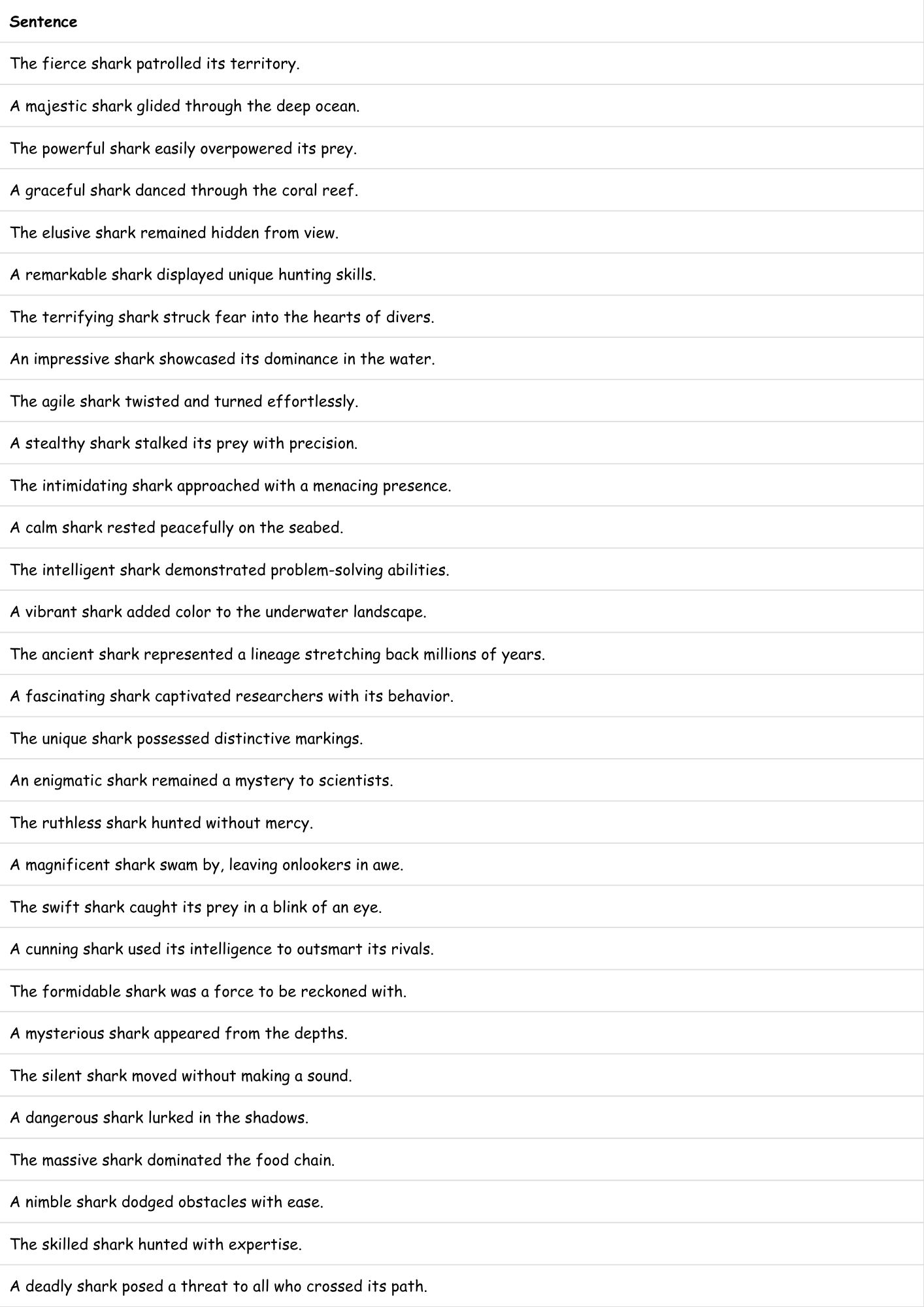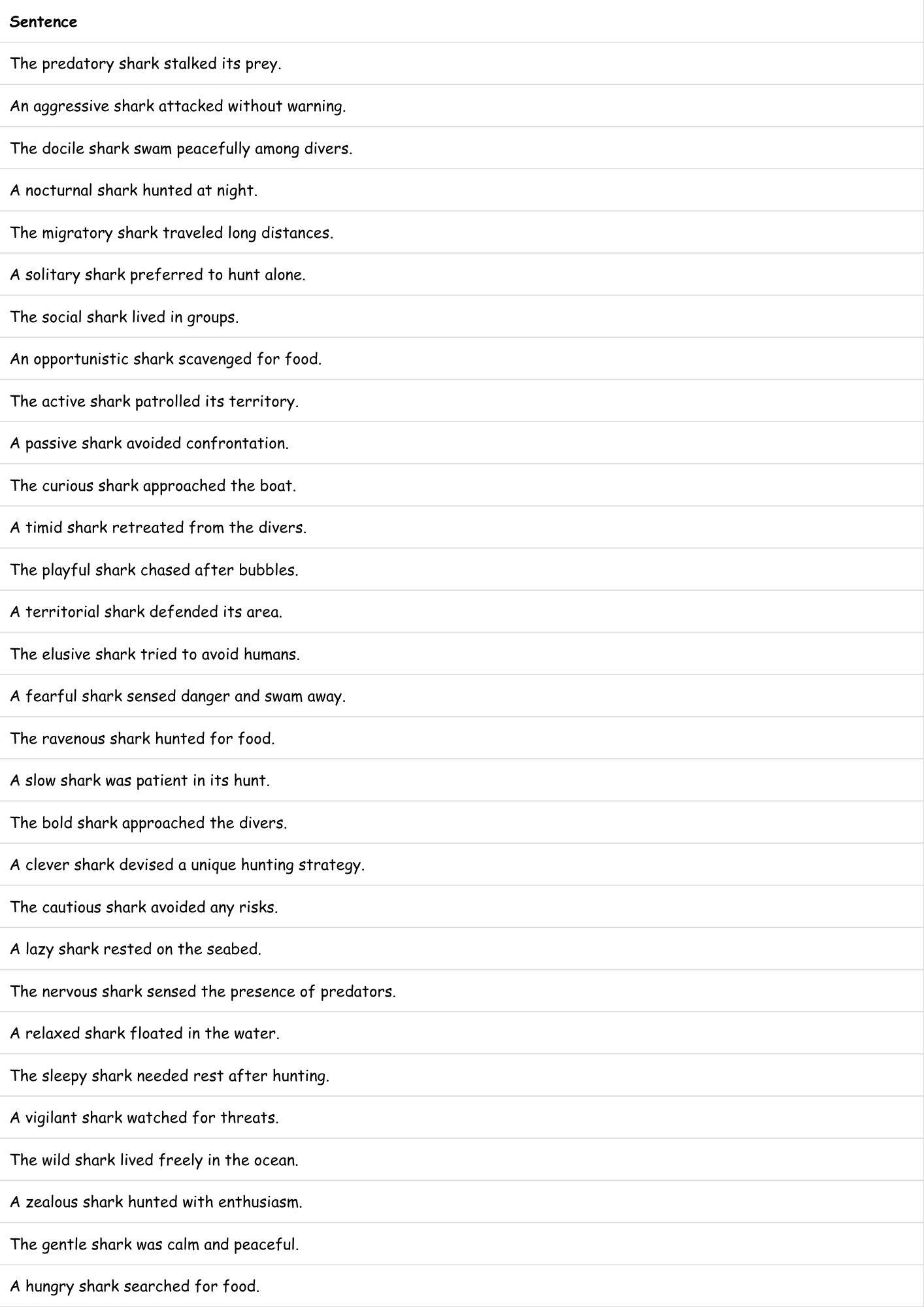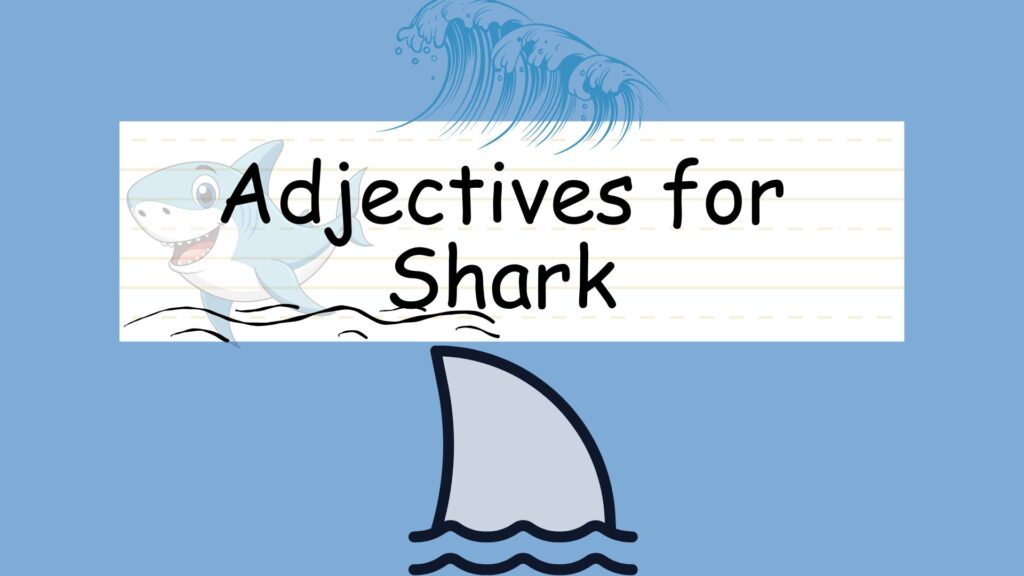Understanding how to use adjectives effectively is crucial for vivid and accurate communication. When describing the fascinating world of sharks, adjectives become particularly important. They allow us to paint a picture of these creatures, highlighting their unique features, behaviors, and habitats. This article will provide a comprehensive guide to adjectives used to describe sharks, covering various types, usage rules, common mistakes, and practice exercises. Whether you’re a student, writer, or simply a shark enthusiast, this guide will enhance your ability to articulate the nuances of these incredible marine animals.
This guide is designed for anyone who wants to improve their descriptive writing and vocabulary related to sharks. From beginners to advanced English learners, the content is structured to cater to various skill levels. By the end of this article, you’ll have a rich understanding of adjectives for sharks and be able to use them confidently in your writing and conversations.
Table of Contents
- Introduction
- Definition of Adjectives
- Structural Breakdown of Adjectives
- Types of Adjectives for Sharks
- Examples of Adjectives for Sharks
- Usage Rules for Adjectives
- Common Mistakes with Adjectives
- Practice Exercises
- Advanced Topics
- FAQ
- Conclusion
Definition of Adjectives
An adjective is a word that modifies or describes a noun or pronoun. Adjectives provide more information about the qualities, characteristics, or state of being of the noun or pronoun they modify. They answer questions like “What kind?”, “Which one?”, “How many?”, or “How much?” by adding detail and specificity to the description.
In the context of describing sharks, adjectives are essential for creating vivid and accurate portrayals. They allow us to distinguish between different species, highlight unique physical traits, and convey behavioral characteristics. For example, instead of simply saying “a shark,” we can use adjectives to say “a large shark,” “a gray shark,” or a “predatory shark,” each conveying different aspects of the creature.
Adjectives can be classified into several types based on their function and meaning. These include descriptive adjectives, quantitative adjectives, demonstrative adjectives, possessive adjectives, and interrogative adjectives. Understanding these different types helps in choosing the most appropriate adjective for a given context, resulting in clearer and more effective communication.
Structural Breakdown of Adjectives
Adjectives typically precede the noun they modify, but they can also follow a linking verb (such as is, are, was, were, seems, appears, becomes). When an adjective precedes a noun, it is called an attributive adjective. When it follows a linking verb, it is called a predicative adjective.
Attributive Adjective: The powerful shark swam through the ocean.
Predicative Adjective: The shark is powerful.
Adjectives can also be modified by adverbs to further enhance their meaning. For example, in the phrase “extremely dangerous shark,” the adverb “extremely” modifies the adjective “dangerous,” making the description more precise.
Some adjectives can be formed by adding suffixes to nouns or verbs. Common suffixes include -ful, -less, -able, -ive, -ous, and -y. For example, the adjective “dangerous” is formed by adding the suffix -ous to the noun “danger.” Similarly, “sleepless” adds “-less” to the noun “sleep.”
The order of adjectives before a noun generally follows a specific pattern, although it is not always strictly adhered to. A common guideline is: opinion, size, age, shape, color, origin, material, and purpose. For example, “a beautiful large old oval gray Japanese silk swimming shark” would be the ideal order, though such a long string of adjectives is rare in practice.
Types of Adjectives for Sharks
Adjectives can be categorized based on the type of information they provide about sharks. Here are several common types of adjectives used to describe sharks:
Descriptive Adjectives
Descriptive adjectives provide general information about the qualities or characteristics of a shark. These adjectives help to create a mental image of the shark and convey its unique features.
Examples: fierce, majestic, powerful, graceful, elusive, remarkable, terrifying, impressive.
Size Adjectives
Size adjectives indicate the physical dimensions of a shark, helping to distinguish between different species or individuals based on their size.
Examples: large, small, huge, tiny, gigantic, massive, miniature, immense.
Color Adjectives
Color adjectives describe the color of a shark, providing visual details that can help identify specific species or individuals.
Examples: gray, white, black, blue, brown, silver, spotted, striped.
Shape Adjectives
Shape adjectives describe the physical form or structure of a shark, including its body shape, fins, and other features.
Examples: streamlined, torpedo-shaped, slender, broad, flat, rounded, pointed, angular.
Behavioral Adjectives
Behavioral adjectives describe the typical actions, habits, or temperament of a shark, providing insight into its behavior and lifestyle.
Examples: predatory, aggressive, docile, nocturnal, migratory, solitary, social, opportunistic.
Habitat Adjectives
Habitat adjectives describe the environment in which a shark lives, providing information about its preferred habitat and geographic distribution.
Examples: deep-sea, coastal, tropical, temperate, reef-dwelling, pelagic, estuarine, benthic.
Dangerous Adjectives
Dangerous adjectives describe the potential threat a shark poses to other animals, including humans.
Examples: dangerous, threatening, hazardous, perilous, menacing, risky, formidable, predatory.
Comparative and Superlative Adjectives
Comparative adjectives compare two things (e.g., “This shark is larger than that one”). Superlative adjectives compare more than two things and indicate the highest degree of a quality (e.g., “This is the largest shark in the ocean”).
Examples:
- Comparative: larger, smaller, fiercer, more dangerous, less common
- Superlative: largest, smallest, fiercest, most dangerous, least common
Examples of Adjectives for Sharks
Here are several examples of adjectives used to describe sharks, organized by category:
Descriptive Adjective Examples
The following table provides a variety of sentences using descriptive adjectives to describe sharks. These adjectives help to paint a vivid picture of the shark’s characteristics and qualities.
| Sentence |
|---|
| The fierce shark patrolled its territory. |
| A majestic shark glided through the deep ocean. |
| The powerful shark easily overpowered its prey. |
| A graceful shark danced through the coral reef. |
| The elusive shark remained hidden from view. |
| A remarkable shark displayed unique hunting skills. |
| The terrifying shark struck fear into the hearts of divers. |
| An impressive shark showcased its dominance in the water. |
| The agile shark twisted and turned effortlessly. |
| A stealthy shark stalked its prey with precision. |
| The intimidating shark approached with a menacing presence. |
| A calm shark rested peacefully on the seabed. |
| The intelligent shark demonstrated problem-solving abilities. |
| A vibrant shark added color to the underwater landscape. |
| The ancient shark represented a lineage stretching back millions of years. |
| A fascinating shark captivated researchers with its behavior. |
| The unique shark possessed distinctive markings. |
| An enigmatic shark remained a mystery to scientists. |
| The ruthless shark hunted without mercy. |
| A magnificent shark swam by, leaving onlookers in awe. |
| The swift shark caught its prey in a blink of an eye. |
| A cunning shark used its intelligence to outsmart its rivals. |
| The formidable shark was a force to be reckoned with. |
| A mysterious shark appeared from the depths. |
| The silent shark moved without making a sound. |
| A dangerous shark lurked in the shadows. |
| The massive shark dominated the food chain. |
| A nimble shark dodged obstacles with ease. |
| The skilled shark hunted with expertise. |
| A deadly shark posed a threat to all who crossed its path. |

Size Adjective Examples
This table showcases how size adjectives can be used to describe sharks, providing a clear understanding of their physical dimensions.
| Sentence |
|---|
| The large shark dominated the reef. |
| A small shark darted among the coral. |
| The huge shark was a sight to behold. |
| A tiny shark pup was barely visible. |
| The gigantic shark dwarfed the surrounding fish. |
| A massive shark swam with immense power. |
| The miniature shark was a unique specimen. |
| An immense shark patrolled the open ocean. |
| The long shark had a distinctive silhouette. |
| A short shark was surprisingly agile. |
| The tall shark stood out among its peers. |
| A wide shark had a broad body. |
| The narrow shark slipped through tight spaces. |
| A thick shark was heavily built. |
| The thin shark was remarkably fast. |
| A petite shark was delicate in appearance. |
| The substantial shark had a significant presence. |
| A compact shark was perfectly adapted to its environment. |
| The bulky shark was slow but powerful. |
| A trim shark was sleek and efficient. |
| The overgrown shark was an anomaly. |
| A undersized shark struggled to compete. |
| The portly shark had an unusual appetite. |
| A slender shark was fast and agile. |
| The voluminous shark took up a lot of space. |
| A skimpy shark was malnourished. |
| The weighty shark was difficult to study. |
| A lightweight shark was easy to maneuver. |
| The stout shark had a strong build. |
| A gangly shark was awkward in its movements. |
Color Adjective Examples
The following table illustrates how color adjectives are used to describe sharks, providing specific details about their coloration and markings.
| Sentence |
|---|
| The gray shark blended into the murky water. |
| A white shark breached the surface. |
| The black shark was difficult to spot at night. |
| A blue shark swam in the open ocean. |
| The brown shark rested on the seabed. |
| A silver shark reflected the sunlight. |
| The spotted shark had unique markings. |
| A striped shark was easily identifiable. |
| The dark shark lurked in the shadows. |
| A light shark was visible from afar. |
| The reddish shark was a rare sight. |
| A yellowish shark was camouflaged in the coral. |
| The multicolored shark was vibrant and striking. |
| A pale shark appeared ghostly in the water. |
| The iridescent shark shimmered in the light. |
| A mottled shark blended into its surroundings. |
| The bronze shark gleamed in the sun. |
| A charcoal shark was almost invisible. |
| The cream shark had a soft appearance. |
| A ebony shark was dark and mysterious. |
| The golden shark was a treasure to see. |
| A ivory shark had a unique color pattern. |
| The jet shark was fast and efficient. |
| A khaki shark was well camouflaged. |
| The lavender shark was a rare sight. |
| A maroon shark was unique and interesting. |
| The navy shark was mysterious and haunting. |
| A olive shark was well camouflaged. |
| The peach shark was a rare sight. |
| A quartz shark was well camouflaged. |
Behavioral Adjective Examples
This table demonstrates how behavioral adjectives can be used to describe the actions, habits, and temperament of sharks, providing insights into their lifestyle.
| Sentence |
|---|
| The predatory shark stalked its prey. |
| An aggressive shark attacked without warning. |
| The docile shark swam peacefully among divers. |
| A nocturnal shark hunted at night. |
| The migratory shark traveled long distances. |
| A solitary shark preferred to hunt alone. |
| The social shark lived in groups. |
| An opportunistic shark scavenged for food. |
| The active shark patrolled its territory. |
| A passive shark avoided confrontation. |
| The curious shark approached the boat. |
| A timid shark retreated from the divers. |
| The playful shark chased after bubbles. |
| A territorial shark defended its area. |
| The elusive shark tried to avoid humans. |
| A fearful shark sensed danger and swam away. |
| The ravenous shark hunted for food. |
| A slow shark was patient in its hunt. |
| The bold shark approached the divers. |
| A clever shark devised a unique hunting strategy. |
| The cautious shark avoided any risks. |
| A lazy shark rested on the seabed. |
| The nervous shark sensed the presence of predators. |
| A relaxed shark floated in the water. |
| The sleepy shark needed rest after hunting. |
| A vigilant shark watched for threats. |
| The wild shark lived freely in the ocean. |
| A zealous shark hunted with enthusiasm. |
| The gentle shark was calm and peaceful. |
| A hungry shark searched for food. |

Usage Rules for Adjectives
Using adjectives correctly involves understanding certain rules and guidelines. Here are some key points to remember:
- Placement: Adjectives usually come before the noun they modify (attributive position) or after a linking verb (predicative position).
- Order: When using multiple adjectives, follow a general order: opinion, size, age, shape, color, origin, material, purpose.
- Comparative and Superlative Forms: For most adjectives, add “-er” for the comparative form and “-est” for the superlative form. For longer adjectives, use “more” and “most.”
- Articles: Use “a” or “an” before singular countable nouns modified by an adjective. The choice depends on the sound of the adjective (e.g., “a dangerous shark,” “an elusive shark”).
- Proper Adjectives: Adjectives derived from proper nouns (e.g., “Japanese”) are capitalized.
Examples of Correct Usage:
- Correct: The large, gray shark swam by.
- Correct: The shark is large and gray.
- Correct: This shark is larger than that one.
- Correct: This is the largest shark I have ever seen.
Common Mistakes with Adjectives
Here are some common mistakes people make when using adjectives:
| Incorrect | Correct | Explanation |
|---|---|---|
| The shark is fiercely. | The shark is fierce. | Adjectives, not adverbs, should follow linking verbs. |
| A dangerous great white shark. | A great white shark. | “Dangerous” is often implied with “great white shark,” but the order is acceptable. |
| This shark is more big than that one. | This shark is bigger than that one. | Use “-er” for the comparative form of short adjectives. |
| The most largest shark. | The largest shark. | Do not use “most” with adjectives that already have a superlative form (-est). |
| An shark is swimming. | A shark is swimming. | Use “a” before words that start with a consonant sound. |
| I saw a japanese shark. | I saw a Japanese shark. | Capitalize proper adjectives. |
| The shark is danger. | The shark is dangerous. | Use the adjective form, not the noun form. |
| The shark swims quick. | The shark swims quickly. | Use an adverb to describe how the shark swims. |
Practice Exercises
Test your understanding of adjectives with these practice exercises:
Exercise 1: Identifying Adjectives
Identify the adjectives in the following sentences:
| Question | Answer |
|---|---|
| 1. The powerful shark swam in the deep ocean. | powerful, deep |
| 2. A small, gray shark darted among the coral. | small, gray |
| 3. The aggressive shark attacked its prey. | aggressive |
| 4. The graceful, elusive shark remained hidden. | graceful, elusive |
| 5. This is a dangerous species of shark. | dangerous |
| 6. The giant shark was truly terrifying. | giant, terrifying |
| 7. A lone shark roamed the ocean floor. | lone |
| 8. The fast shark swam by in a flash. | fast |
| 9. That hungry shark is hunting for prey. | hungry |
| 10. The camouflaged shark blended into the reef. | camouflaged |
Exercise 2: Filling in the Blanks
Fill in the blanks with appropriate adjectives:
| Question | Answer |
|---|---|
| 1. The _______ shark is known for its size. | large/huge/gigantic |
| 2. A _______ shark is hard to spot. | elusive/stealthy |
| 3. The _______ shark hunted at night. | nocturnal |
| 4. This _______ shark is very old. | ancient |
| 5. The _______ shark is a threat to swimmers. | dangerous |
| 6. A _______ shark swam through the reef. | colorful |
| 7. The _______ shark is known for its speed. | fast |
| 8. This _______ shark is a rare sight. | unique |
| 9. The _______ shark has a distinctive pattern. | spotted/striped |
| 10. A _______ shark can be quite intimidating. | massive |
Exercise 3: Rewriting Sentences
Rewrite the following sentences using more descriptive adjectives:
| Question | Answer |
|---|---|
| 1. The shark swam in the ocean. | The powerful shark swam in the deep ocean. |
| 2. A shark was seen near the reef. | A small, gray shark was seen near the vibrant reef. |
| 3. The shark attacked. | The aggressive shark attacked its prey fiercely. |
| 4. The shark hid. | The graceful, elusive shark remained hidden from view. |
| 5. The shark is dangerous. | This is a dangerous species of shark, known for its aggression. |
| 6. The shark was big. | The giant shark was truly terrifying. |
| 7. A shark roamed the floor. | A lone shark roamed the dark ocean floor. |
| 8. The shark swam by. | The fast shark swam by in a blur. |
| 9. The shark is hungry. | That hungry shark is hunting for unsuspecting prey. |
| 10. The shark blended in. | The camouflaged shark blended seamlessly into the reef. |
Advanced Topics
For advanced learners, consider exploring these topics:
- Abstract Adjectives: Adjectives that describe intangible qualities (e.g., courageous, mysterious).
- Compound Adjectives: Adjectives made up of two or more words (e.g., deep-sea, cold-blooded).
- Participial Adjectives: Adjectives formed from verbs (e.g., terrifying, fascinating).
- Adjective Phrases: Phrases that function as adjectives (e.g., “a shark with sharp teeth“).
- The Subjunctive Mood with Adjectives: Using adjectives in hypothetical or conditional sentences (e.g., “If the shark were more dangerous, we would not swim here”).
FAQ
- What is the difference between an adjective and an adverb?Adjectives modify nouns or pronouns, while adverbs modify verbs, adjectives, or other adverbs. For example, “The fierce shark” (adjective) vs. “The shark hunted fiercely” (adverb).
- Can a noun be used as an adjective?Yes, nouns can function as adjectives, often called attributive nouns or noun adjuncts. For example, “shark attack” where “shark” modifies the noun “attack.”
- How do I choose the right adjective?Consider the specific quality or characteristic you want to emphasize. Use a thesaurus to find synonyms and choose the word that best conveys your intended meaning.
- What if I can’t think of any adjectives?Start by observing the shark closely and noting its physical features, behavior, and habitat. Use these observations to brainstorm a list of possible adjectives.
- Can I use too many adjectives?Yes, using too many adjectives can make your writing cluttered and difficult to read. Choose adjectives carefully and use them sparingly for maximum impact.
- How do I improve my vocabulary of adjectives?Read widely, pay attention to how adjectives are used in different contexts, and make a habit of looking up unfamiliar words. Practice using new adjectives in your writing and conversation.
- What is the order of adjectives when using multiple adjectives to describe a shark?A general guideline is: opinion, size, age, shape, color, origin, material, purpose. For example: “a beautiful large old oval gray Japanese silk swimming shark.”
- Are some adjectives more effective than others when describing sharks?Yes, the most effective adjectives are those that accurately and vividly convey the unique qualities of the shark you are describing. Consider your audience and purpose when choosing adjectives.
Conclusion
Mastering the use of adjectives is crucial for enhancing the clarity and vividness of your writing, especially when describing subjects as captivating as sharks. By understanding the different types of adjectives, their structural roles, and the rules governing their usage, you can effectively paint a picture of these magnificent creatures. Avoid common mistakes and practice regularly to improve your skills.
Remember to pay attention to the nuances of language and choose adjectives that accurately reflect the qualities you want to highlight. With practice and attention to detail, you can become proficient in using adjectives to bring your descriptions of sharks to life. Keep exploring, keep learning, and keep practicing!



